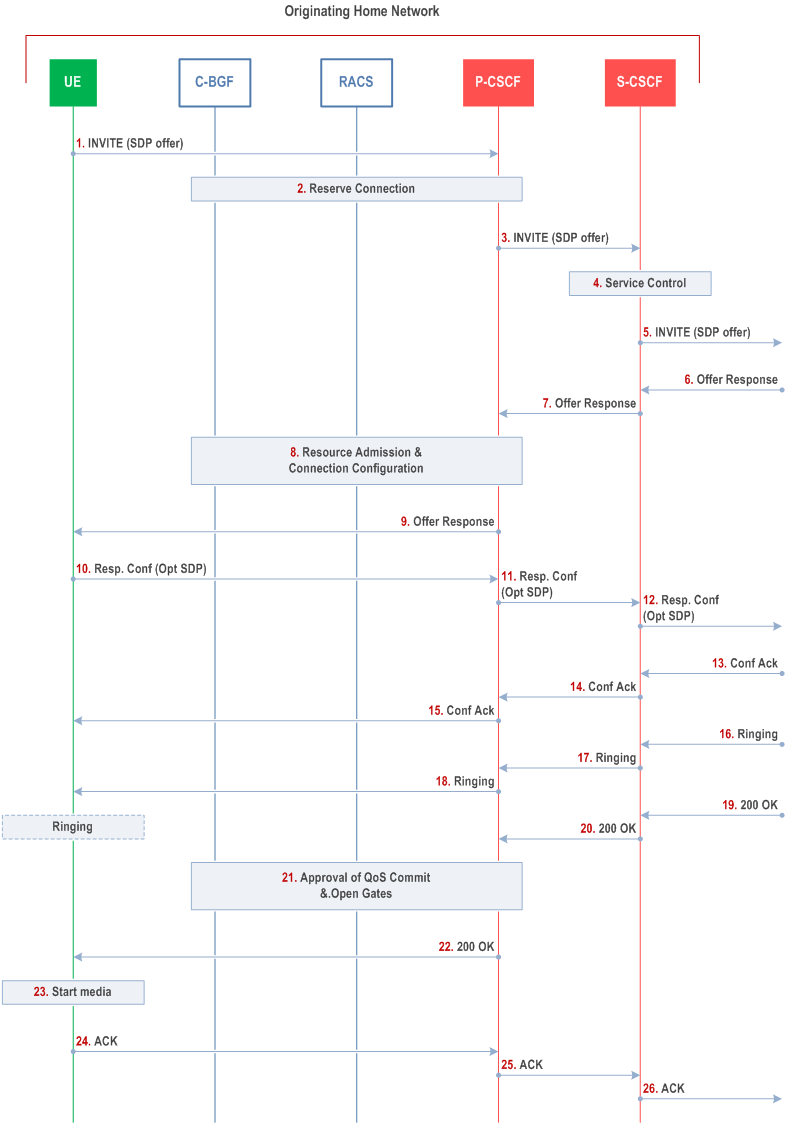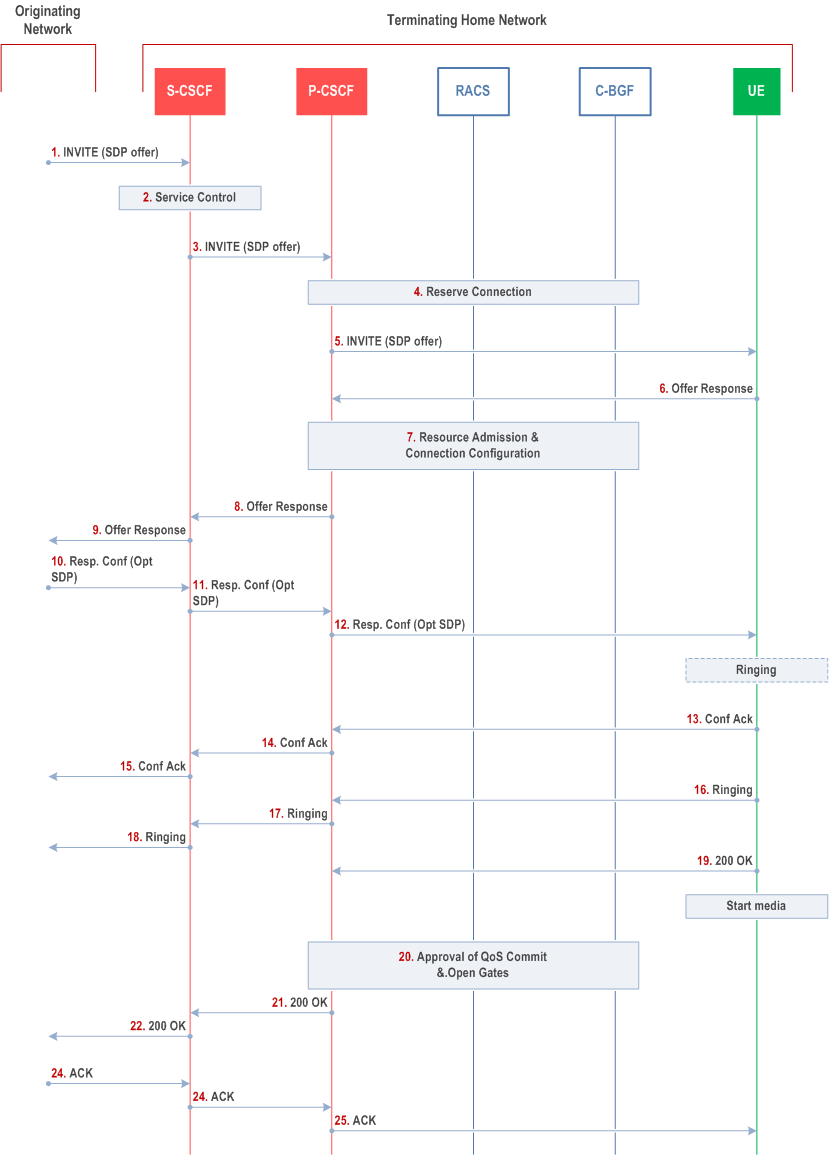Content for TS 23.228 Word version: 18.6.0
1…
3…
4…
4.2.4…
4.3…
4.4…
4.13…
4.16…
5…
5.2…
5.3…
5.4…
5.4.7…
5.4.8…
5.4a…
5.5…
5.5.3…
5.6…
5.6.3…
5.7…
5.7.3…
5.7.5…
5.7.8…
5.8…
5.10…
5.11…
5.11.3…
5.11.3.3
5.11.3.4
5.11.4…
5.11.5…
5.11.5.3…
5.11.6…
5.12…
5.16…
5.16.2…
5.19…
5.20…
A…
E…
E.2.2…
G…
G.5…
H
I…
J…
K…
L…
M…
M.3…
N…
P…
Q…
Q.2.5…
R…
S…
T…
U…
U.2…
V…
W…
X…
Y…
Z…
AA…
AA.3…
AB…
AC…
AC.7…
AC.7.2…
AC.7.2.2
AC.7.2.3…
AC.7.4…
AC.9…
N Aspects for use of Common IMS in Fixed xDSL, Fiber and Ethernet based systems
N.1 Origination procedures
N.1.1 (FO#1) Fixed xDSL origination, home
N.2 Termination procedures
N.2.1 (FT#1) Fixed xDSL termination, home
N.3 Geographical Identifier
...
...
N (Normative) Aspects for use of Common IMS in Fixed xDSL, Fiber and Ethernet based systems |R8| p. 272
N.1 Origination procedures p. 272
N.1.1 (FO#1) Fixed xDSL origination, home p. 272
This origination procedure applies to users located in their home service area. As in clause 5.6.2, the UE is located in the home network, but is using an xDSL IP-CAN to access the IM CN Subsystem.

Procedure F0#1 is as follows:
Step 1.
UE sends the SIP INVITE request, containing an initial SDP, to the P-CSCF address determined with P-CSCF discovery mechanism. The initial SDP may represent one or more media for a multi-media session.
Step 2.
A connection is reserved in the C-BGF with optional NAT binding list retrieval.
Step 3.
P-CSCF remembers (from the registration procedure) the next hop CSCF for this UE. In this case it forwards the INVITE to the S-CSCF in the home network.
Step 4.
S-CSCF validates the service profile, and invokes any origination service logic required for this user. This includes authorization of the requested SDP based on the user's subscription for multi-media services.
Step 5.
S-CSCF forwards the request, as specified by the S-S procedures. In addition, subject to operator policy, the S-CSCF may insert in the request a reference location of the user, when network-provided location information is not already present. The reference location (e.g. line identification) is determined by the operator as part of the user profile and may be received from the HSS at registration.
Step 6.
The media stream capabilities of the destination are returned along the signalling path, per the S-S procedures.
Step 7-9.
S-CSCF forwards the Offer Response message to the P-CSCF which triggers RACS. RACS performs admission control based on the Offer and Answer parameters.
RACS configures the connections in the C-BGF based on the SDP answer and optionally requests a NAT binding list.
Step 10.
UE decides the offered set of media streams for this session, confirms receipt of the Offer Response and sends the Response Confirmation to P-CSCF. The Response Confirmation may also contain SDP. This may be the same SDP as in the Offer Response received in step 9 or a subset. If new media are defined by this SDP, a new connection configuration shall be performed following step 2. The originating UE is free to continue to offer new media in this request or in subsequent requests using the Update method. Each offer/answer exchange will cause the P-CSCF to repeat the RACS interactions again.
Step 11.
P-CSCF forwards this message to S-CSCF
Step 12.
S-CSCF forwards this message to the terminating endpoint, as per the S-S procedure.
Step 13.
The terminating end point responds to the originating end with an acknowledgement. If Optional SDP is contained in the Response Confirmation, the Confirmation Acknowledge will also contain an SDP response. If the SDP has changed, the admission control and configure connection flows are repeated.
Step 14-15.
S-CSCF and P-CSCF forward the answered media towards the UE.
Step 16-18.
The destination UE may optionally perform alerting. If so, it signals this to the originating party by a provisional response indicating Ringing. This message is sent to S-CSCF per the S-S procedure. It is sent from there toward the originating end along the signalling path. UE indicates to the originating user that the destination is ringing.
Step 19-20.
When the destination party answers, the terminating endpoint sends a SIP 200-OK final response along the signalling path to the originating endpoint, as specified by the termination procedures and the S-S procedures.
Step 21.
P-CSCF performs the approval of QoS Commit procedure which triggers the Open Gates procedures if required.
Step 22.
P-CSCF passes the 200-OK response back to UE.
Step 23.
UE starts the media flow(s) for this session.
Step 24-26.
UE responds to the 200 OK with an ACK message which is sent to P-CSCF and passed along the signalling path to the terminating endpoint.
N.2 Termination procedures p. 274
N.2.1 (FT#1) Fixed xDSL termination, home p. 274
This termination procedure applies to users located in their home service area. As in clause 5.7.2, the UE is located in the home network, but has registered to the IM CN Subsystem via an xDSL IP-CAN.

Procedure FT#1 is as follows:
Step 1.
UE#1 sends the SIP INVITE request, containing an initial SDP, via one of the origination procedures and the S-S procedures, to the S-CSCF for the terminating UE.
Step 2.
S-CSCF validates the service profile, and invokes any termination service logic required. This includes authorization of the requested SDP based on the user's subscription for multi-media services.
Step 3.
S-CSCF remembers (from the registration procedure) the P-CSCF address for this UE. The S-CSCF forwards the INVITE to the P-CSCF, which in this case is located in the home network.
Step 4.
The P-CSCF triggers RACS which reserves a connection in C-BGF with optional NAT binding retrieval.
Step 5.
P-CSCF remembers (from the registration procedure) the UE address, and forwards the INVITE to the UE.
Step 6.
UE determines the subset of the media flows proposed by the originating endpoint that it is capable and willing to support, and responds with an Offer Response message back to the originator. The SDP may represent one or more media for a multi-media session. This response is sent to the P-CSCF.
Step 7.
P-CSCF triggers RACS to perform admission control based on Offer and Answer parameters.
RACS configures the connection in the C-BGF based on SDP answer with optional NAT binding retrieval.
Step 8.
P-CSCF forwards the Offer Response message to S-CSCF.
Step 9.
S-CSCF forwards the Offer Response message to the originator, per the S-S procedure.
Step 10-15.
The originating endpoint sends a Response Confirmation via the S-S procedure, to the terminating S-CSCF. The Response Confirmation may also contain SDP. This may be the same SDP as in the Offer Response sent in step 19 or a subset. If new media are defined by this SDP, a new interaction with the RACS (as in steps 4-8) will be done by the P-CSCF. The originating UE is free to continue to offer new media in this request or in a subsequent request using the Update method. Each offer/answer exchange will cause the P-CSCF to repeat the RACS interactions (steps 4-8) again.
Step 16-18.
UE may alert the user and wait for an indication from the user before completing the session. If so, it indicates this to the originating party by a provisional response indicating Ringing. This message is sent to P-CSCF and along the signalling path to the originating endpoint.
Step 19.
When the destination party answers, UE sends a SIP 200 OK final response to P-CSCF.
Step 20.
P-CSCF indicates that the resources reserved for this session should now be committed.
Step 21-22.
P-CSCF forwards the 200 OK to S-CSCF, following the signalling path.
Step 23-25.
The session originator responds to the 200 OK by sending the ACK message to S-CSCF via the S-S procedure and it is forwarded to the terminating end along the signalling path.
N.3 Geographical Identifier |R12| p. 275
For fixed xDSL, Fiber or Ethernet access, Geographical Identifier may be used within the IMS as described in clause E.8.